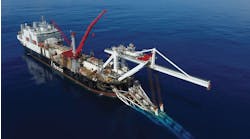Offshore staff
LONDON -- Rockhopper Exploration has completed testing of its Sea Lion oil discovery well in the North Falkland basin.
The Sea Lion 1 well was drilled in a water depth of 451 m (1,479 ft) during April and May, before being suspended for future testing. It intersected a gross oil column of 217 m (712 ft) with net pay of 53 m (174 ft). Initial MDT samples revealed a medium-grade crude of 26 .4 – 29.2º API gravity.
Earlier this month the semisubmersible Ocean Guardian re-entered the well, which was flowed for 18 hours, testing at sustained rates of over 2,000 b/d of oil with a maximum rate of 2,304 b/d.
Rockhopper says these results met its pre-test expectations, despite being constrained by the downhole and surface equipment. The well produced neither water nor hydrogen sulfide (H2S), and only minor amounts of CO2. The rig team also recorded downhole pressures, and the analyses will be used in the Sea Lion development scoping plans. Downhole and surface samples were complied also for analysis in the UK.
The equipment constraints were due to logistics and timeline issues. Rockhopper anticipates that more suitable items would be brought in for any future test, which, combined with an optimal well location, would result in a much higher flow rate.
Pierre Jungels, executive chairman said: “The test has provided vital information which will allow us to move forward through appraisal, a key step in proving the reserves discovered. We believe that Sea Lion is the largest fan sandstone body in the North Falkland basin and, given this successful flow test, that the Sea Lion discovery will be commercially viable.”
09/20/2010


